Strategic Management Analysis of P&G and Unilever
VerifiedAdded on 2020/03/23
|17
|3933
|168
Report
AI Summary
This report analyzes the strategic management approaches of P&G and Unilever in the Chinese market. It examines their core competencies, strategic models, and competitive advantages, highlighting the differences in their market entry strategies and performance. The report utilizes frameworks such as the McKinsey 7S model, Porter’s 5 Forces, and the Ansoff Matrix to evaluate the companies' strategies. It concludes with recommendations for both companies to enhance their market presence and operational efficiency in China.
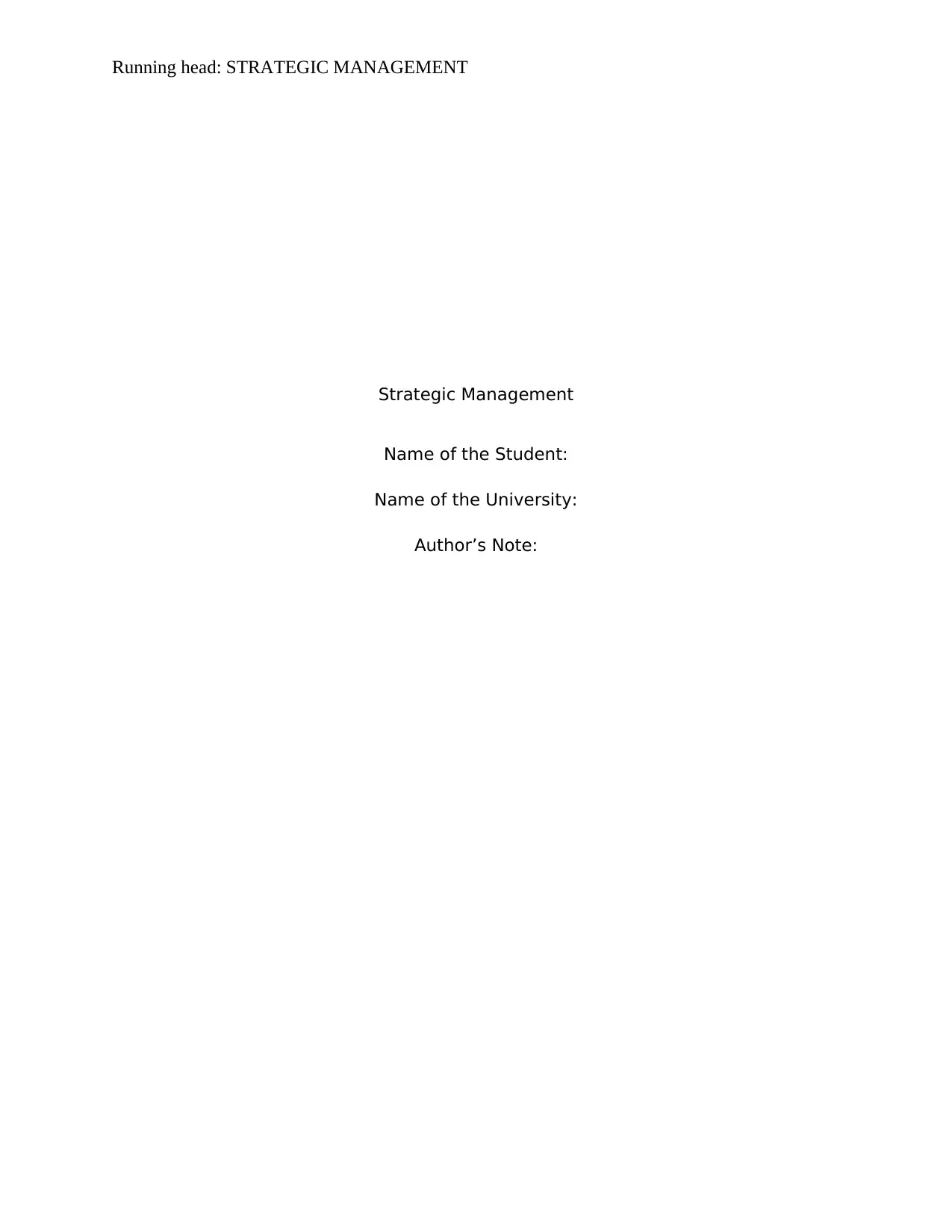
Running head: STRATEGIC MANAGEMENT
Strategic Management
Name of the Student:
Name of the University:
Author’s Note:
Strategic Management
Name of the Student:
Name of the University:
Author’s Note:
Paraphrase This Document
Need a fresh take? Get an instant paraphrase of this document with our AI Paraphraser

1STRATEGIC MANAGEMENT
Executive Summary
In this report, the strategies, core competencies and capabilities of the fast moving
consumer goods company, P& G and Unilever are analyzed with reference to same
market China. The various strategic models used to analyze the strategic actions of
Unilever and P& G are Porter’s 5 Forces Model, Porter’s Generic Strategy, Ansoff’s
Matrix, Blue Ocean Strategy. The new products market, new country markets,
alliances and acquisitions of both the organizations are analyzed. The strategic
action plans of Unilever and P& G are compared and contrasted with emphasis on
the Chinese market. In this report, it can be concluded that P&G was more
successful in the Chinese market as the company focused on gaining trust of
consumers while Unilever entered into multiple joined ventures initially in China and
thus generated lower revenue. However, Unilever later brought its business units
under a single holding in China.
Executive Summary
In this report, the strategies, core competencies and capabilities of the fast moving
consumer goods company, P& G and Unilever are analyzed with reference to same
market China. The various strategic models used to analyze the strategic actions of
Unilever and P& G are Porter’s 5 Forces Model, Porter’s Generic Strategy, Ansoff’s
Matrix, Blue Ocean Strategy. The new products market, new country markets,
alliances and acquisitions of both the organizations are analyzed. The strategic
action plans of Unilever and P& G are compared and contrasted with emphasis on
the Chinese market. In this report, it can be concluded that P&G was more
successful in the Chinese market as the company focused on gaining trust of
consumers while Unilever entered into multiple joined ventures initially in China and
thus generated lower revenue. However, Unilever later brought its business units
under a single holding in China.
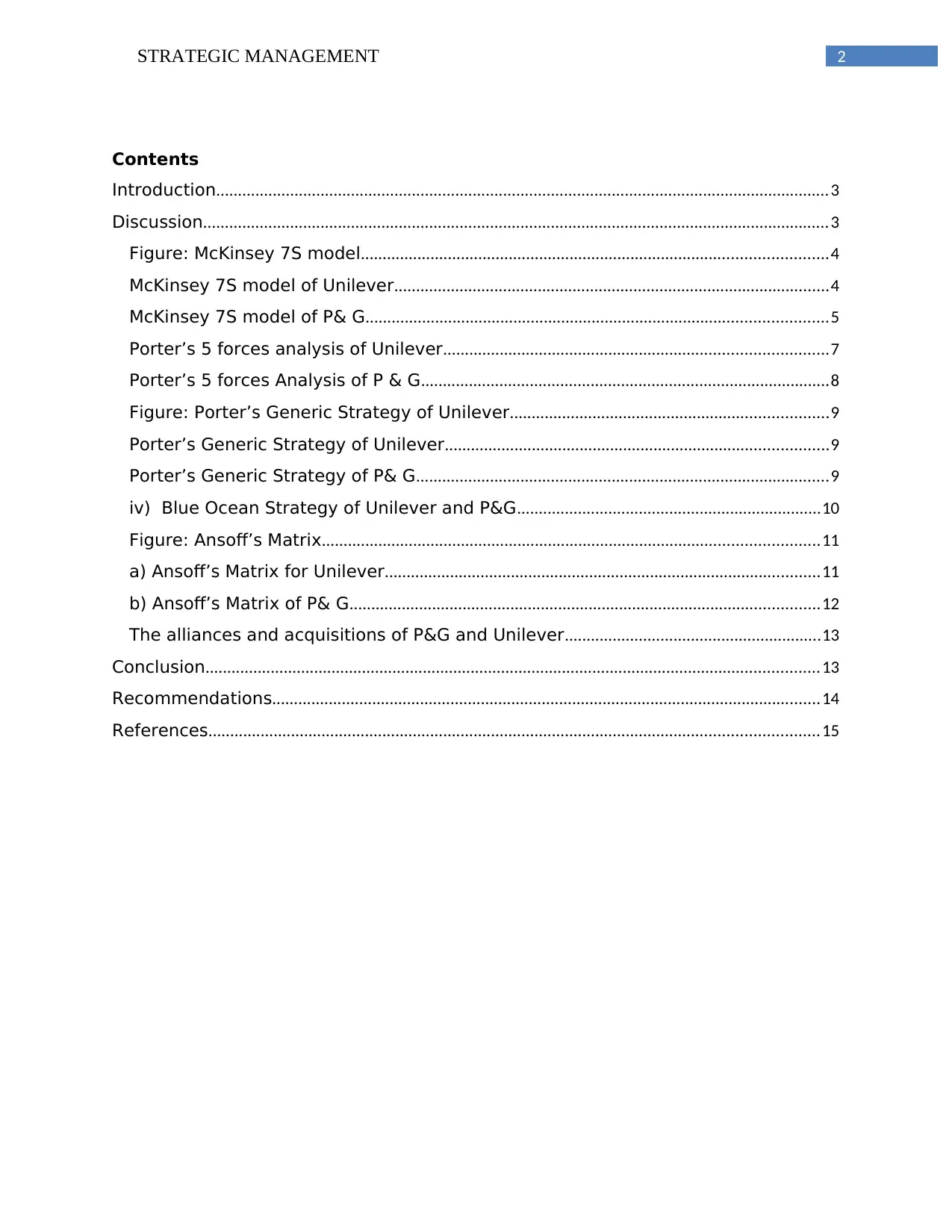
2STRATEGIC MANAGEMENT
Contents
Introduction.............................................................................................................................................3
Discussion................................................................................................................................................3
Figure: McKinsey 7S model...........................................................................................................4
McKinsey 7S model of Unilever....................................................................................................4
McKinsey 7S model of P& G..........................................................................................................5
Porter’s 5 forces analysis of Unilever........................................................................................7
Porter’s 5 forces Analysis of P & G..............................................................................................8
Figure: Porter’s Generic Strategy of Unilever.........................................................................9
Porter’s Generic Strategy of Unilever........................................................................................9
Porter’s Generic Strategy of P& G...............................................................................................9
iv) Blue Ocean Strategy of Unilever and P&G......................................................................10
Figure: Ansoff’s Matrix..................................................................................................................11
a) Ansoff’s Matrix for Unilever....................................................................................................11
b) Ansoff’s Matrix of P& G............................................................................................................12
The alliances and acquisitions of P&G and Unilever...........................................................13
Conclusion.............................................................................................................................................13
Recommendations..............................................................................................................................14
References............................................................................................................................................15
Contents
Introduction.............................................................................................................................................3
Discussion................................................................................................................................................3
Figure: McKinsey 7S model...........................................................................................................4
McKinsey 7S model of Unilever....................................................................................................4
McKinsey 7S model of P& G..........................................................................................................5
Porter’s 5 forces analysis of Unilever........................................................................................7
Porter’s 5 forces Analysis of P & G..............................................................................................8
Figure: Porter’s Generic Strategy of Unilever.........................................................................9
Porter’s Generic Strategy of Unilever........................................................................................9
Porter’s Generic Strategy of P& G...............................................................................................9
iv) Blue Ocean Strategy of Unilever and P&G......................................................................10
Figure: Ansoff’s Matrix..................................................................................................................11
a) Ansoff’s Matrix for Unilever....................................................................................................11
b) Ansoff’s Matrix of P& G............................................................................................................12
The alliances and acquisitions of P&G and Unilever...........................................................13
Conclusion.............................................................................................................................................13
Recommendations..............................................................................................................................14
References............................................................................................................................................15
⊘ This is a preview!⊘
Do you want full access?
Subscribe today to unlock all pages.

Trusted by 1+ million students worldwide
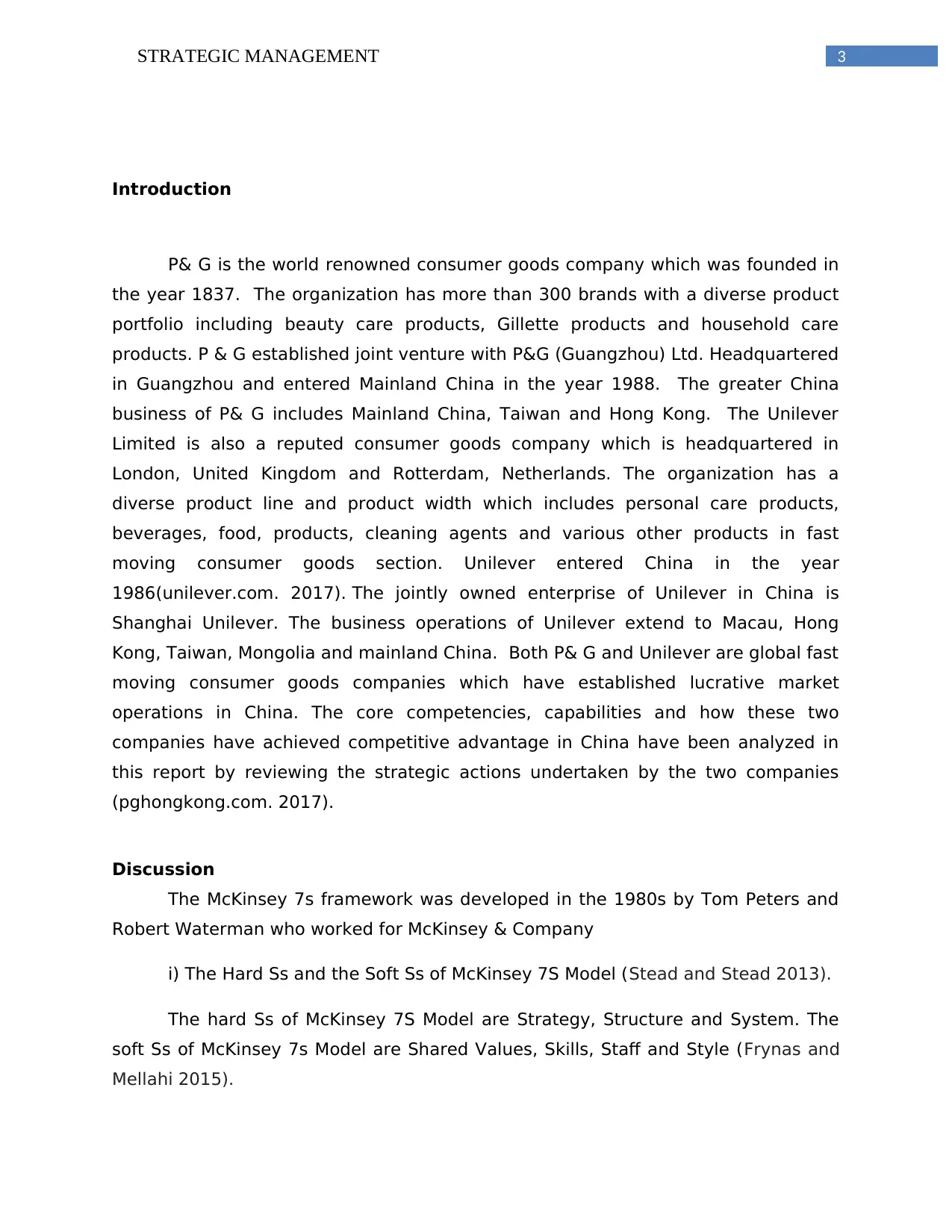
3STRATEGIC MANAGEMENT
Introduction
P& G is the world renowned consumer goods company which was founded in
the year 1837. The organization has more than 300 brands with a diverse product
portfolio including beauty care products, Gillette products and household care
products. P & G established joint venture with P&G (Guangzhou) Ltd. Headquartered
in Guangzhou and entered Mainland China in the year 1988. The greater China
business of P& G includes Mainland China, Taiwan and Hong Kong. The Unilever
Limited is also a reputed consumer goods company which is headquartered in
London, United Kingdom and Rotterdam, Netherlands. The organization has a
diverse product line and product width which includes personal care products,
beverages, food, products, cleaning agents and various other products in fast
moving consumer goods section. Unilever entered China in the year
1986(unilever.com. 2017). The jointly owned enterprise of Unilever in China is
Shanghai Unilever. The business operations of Unilever extend to Macau, Hong
Kong, Taiwan, Mongolia and mainland China. Both P& G and Unilever are global fast
moving consumer goods companies which have established lucrative market
operations in China. The core competencies, capabilities and how these two
companies have achieved competitive advantage in China have been analyzed in
this report by reviewing the strategic actions undertaken by the two companies
(pghongkong.com. 2017).
Discussion
The McKinsey 7s framework was developed in the 1980s by Tom Peters and
Robert Waterman who worked for McKinsey & Company
i) The Hard Ss and the Soft Ss of McKinsey 7S Model (Stead and Stead 2013).
The hard Ss of McKinsey 7S Model are Strategy, Structure and System. The
soft Ss of McKinsey 7s Model are Shared Values, Skills, Staff and Style (Frynas and
Mellahi 2015).
Introduction
P& G is the world renowned consumer goods company which was founded in
the year 1837. The organization has more than 300 brands with a diverse product
portfolio including beauty care products, Gillette products and household care
products. P & G established joint venture with P&G (Guangzhou) Ltd. Headquartered
in Guangzhou and entered Mainland China in the year 1988. The greater China
business of P& G includes Mainland China, Taiwan and Hong Kong. The Unilever
Limited is also a reputed consumer goods company which is headquartered in
London, United Kingdom and Rotterdam, Netherlands. The organization has a
diverse product line and product width which includes personal care products,
beverages, food, products, cleaning agents and various other products in fast
moving consumer goods section. Unilever entered China in the year
1986(unilever.com. 2017). The jointly owned enterprise of Unilever in China is
Shanghai Unilever. The business operations of Unilever extend to Macau, Hong
Kong, Taiwan, Mongolia and mainland China. Both P& G and Unilever are global fast
moving consumer goods companies which have established lucrative market
operations in China. The core competencies, capabilities and how these two
companies have achieved competitive advantage in China have been analyzed in
this report by reviewing the strategic actions undertaken by the two companies
(pghongkong.com. 2017).
Discussion
The McKinsey 7s framework was developed in the 1980s by Tom Peters and
Robert Waterman who worked for McKinsey & Company
i) The Hard Ss and the Soft Ss of McKinsey 7S Model (Stead and Stead 2013).
The hard Ss of McKinsey 7S Model are Strategy, Structure and System. The
soft Ss of McKinsey 7s Model are Shared Values, Skills, Staff and Style (Frynas and
Mellahi 2015).
Paraphrase This Document
Need a fresh take? Get an instant paraphrase of this document with our AI Paraphraser
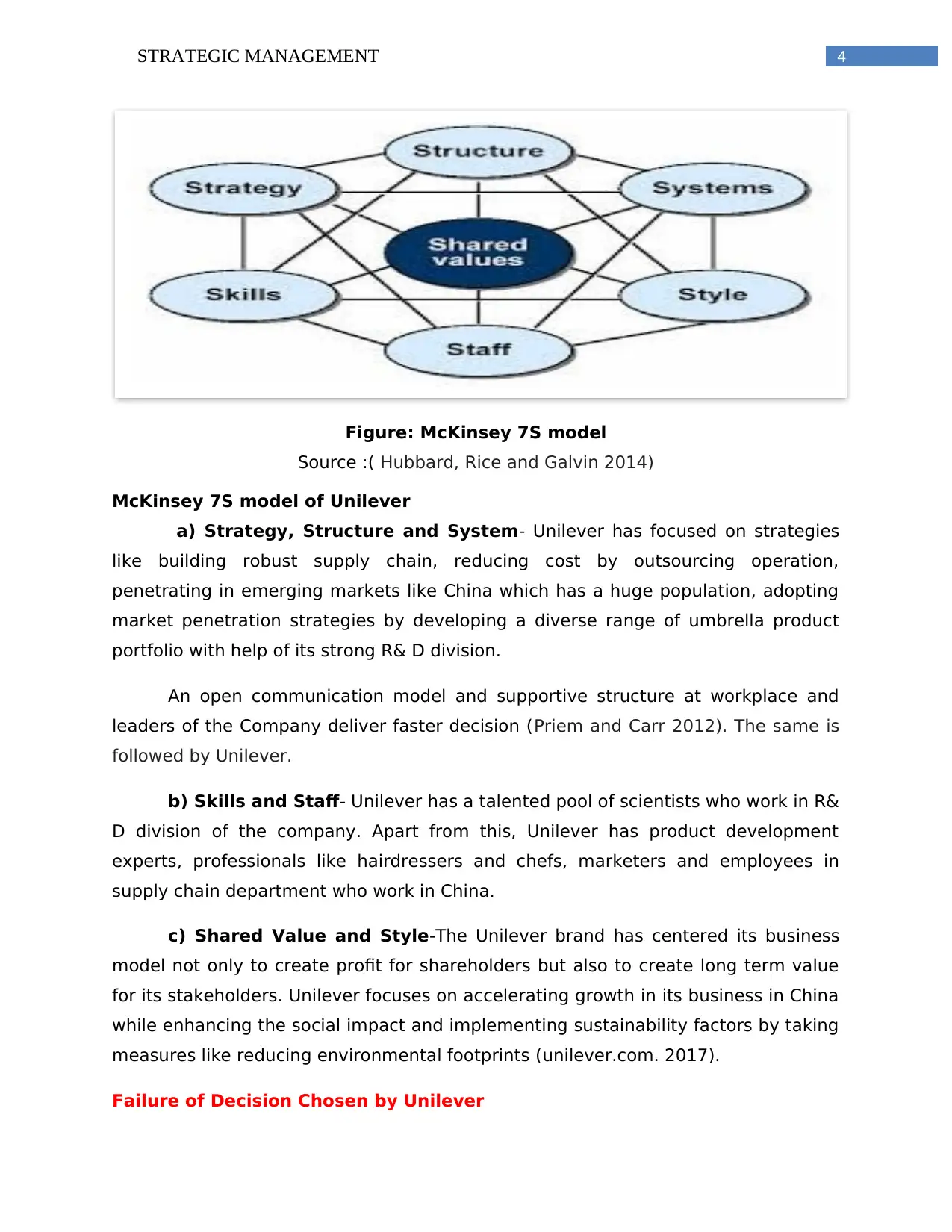
4STRATEGIC MANAGEMENT
Figure: McKinsey 7S model
Source :( Hubbard, Rice and Galvin 2014)
McKinsey 7S model of Unilever
a) Strategy, Structure and System- Unilever has focused on strategies
like building robust supply chain, reducing cost by outsourcing operation,
penetrating in emerging markets like China which has a huge population, adopting
market penetration strategies by developing a diverse range of umbrella product
portfolio with help of its strong R& D division.
An open communication model and supportive structure at workplace and
leaders of the Company deliver faster decision (Priem and Carr 2012). The same is
followed by Unilever.
b) Skills and Staff- Unilever has a talented pool of scientists who work in R&
D division of the company. Apart from this, Unilever has product development
experts, professionals like hairdressers and chefs, marketers and employees in
supply chain department who work in China.
c) Shared Value and Style-The Unilever brand has centered its business
model not only to create profit for shareholders but also to create long term value
for its stakeholders. Unilever focuses on accelerating growth in its business in China
while enhancing the social impact and implementing sustainability factors by taking
measures like reducing environmental footprints (unilever.com. 2017).
Failure of Decision Chosen by Unilever
Figure: McKinsey 7S model
Source :( Hubbard, Rice and Galvin 2014)
McKinsey 7S model of Unilever
a) Strategy, Structure and System- Unilever has focused on strategies
like building robust supply chain, reducing cost by outsourcing operation,
penetrating in emerging markets like China which has a huge population, adopting
market penetration strategies by developing a diverse range of umbrella product
portfolio with help of its strong R& D division.
An open communication model and supportive structure at workplace and
leaders of the Company deliver faster decision (Priem and Carr 2012). The same is
followed by Unilever.
b) Skills and Staff- Unilever has a talented pool of scientists who work in R&
D division of the company. Apart from this, Unilever has product development
experts, professionals like hairdressers and chefs, marketers and employees in
supply chain department who work in China.
c) Shared Value and Style-The Unilever brand has centered its business
model not only to create profit for shareholders but also to create long term value
for its stakeholders. Unilever focuses on accelerating growth in its business in China
while enhancing the social impact and implementing sustainability factors by taking
measures like reducing environmental footprints (unilever.com. 2017).
Failure of Decision Chosen by Unilever
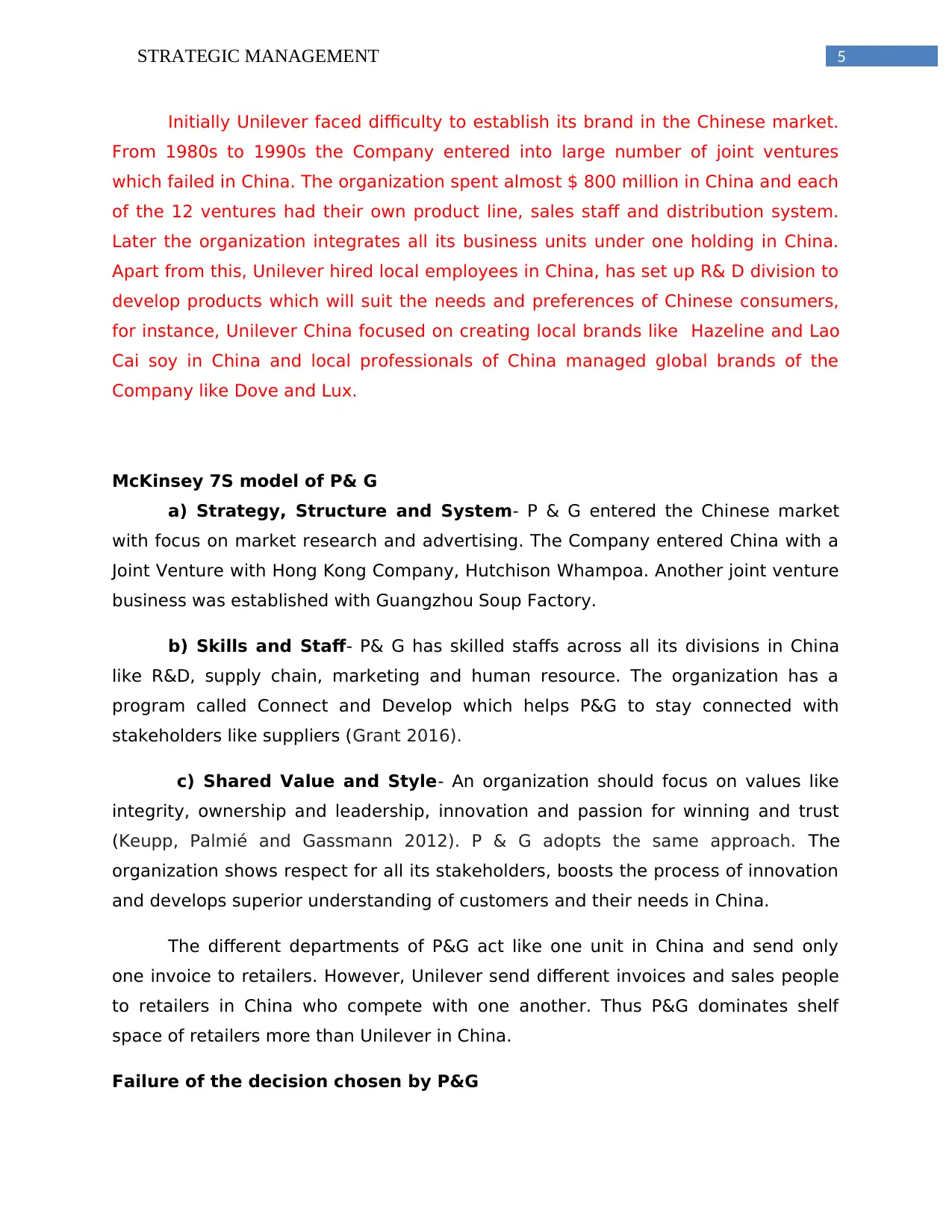
5STRATEGIC MANAGEMENT
Initially Unilever faced difficulty to establish its brand in the Chinese market.
From 1980s to 1990s the Company entered into large number of joint ventures
which failed in China. The organization spent almost $ 800 million in China and each
of the 12 ventures had their own product line, sales staff and distribution system.
Later the organization integrates all its business units under one holding in China.
Apart from this, Unilever hired local employees in China, has set up R& D division to
develop products which will suit the needs and preferences of Chinese consumers,
for instance, Unilever China focused on creating local brands like Hazeline and Lao
Cai soy in China and local professionals of China managed global brands of the
Company like Dove and Lux.
McKinsey 7S model of P& G
a) Strategy, Structure and System- P & G entered the Chinese market
with focus on market research and advertising. The Company entered China with a
Joint Venture with Hong Kong Company, Hutchison Whampoa. Another joint venture
business was established with Guangzhou Soup Factory.
b) Skills and Staff- P& G has skilled staffs across all its divisions in China
like R&D, supply chain, marketing and human resource. The organization has a
program called Connect and Develop which helps P&G to stay connected with
stakeholders like suppliers (Grant 2016).
c) Shared Value and Style- An organization should focus on values like
integrity, ownership and leadership, innovation and passion for winning and trust
(Keupp, Palmié and Gassmann 2012). P & G adopts the same approach. The
organization shows respect for all its stakeholders, boosts the process of innovation
and develops superior understanding of customers and their needs in China.
The different departments of P&G act like one unit in China and send only
one invoice to retailers. However, Unilever send different invoices and sales people
to retailers in China who compete with one another. Thus P&G dominates shelf
space of retailers more than Unilever in China.
Failure of the decision chosen by P&G
Initially Unilever faced difficulty to establish its brand in the Chinese market.
From 1980s to 1990s the Company entered into large number of joint ventures
which failed in China. The organization spent almost $ 800 million in China and each
of the 12 ventures had their own product line, sales staff and distribution system.
Later the organization integrates all its business units under one holding in China.
Apart from this, Unilever hired local employees in China, has set up R& D division to
develop products which will suit the needs and preferences of Chinese consumers,
for instance, Unilever China focused on creating local brands like Hazeline and Lao
Cai soy in China and local professionals of China managed global brands of the
Company like Dove and Lux.
McKinsey 7S model of P& G
a) Strategy, Structure and System- P & G entered the Chinese market
with focus on market research and advertising. The Company entered China with a
Joint Venture with Hong Kong Company, Hutchison Whampoa. Another joint venture
business was established with Guangzhou Soup Factory.
b) Skills and Staff- P& G has skilled staffs across all its divisions in China
like R&D, supply chain, marketing and human resource. The organization has a
program called Connect and Develop which helps P&G to stay connected with
stakeholders like suppliers (Grant 2016).
c) Shared Value and Style- An organization should focus on values like
integrity, ownership and leadership, innovation and passion for winning and trust
(Keupp, Palmié and Gassmann 2012). P & G adopts the same approach. The
organization shows respect for all its stakeholders, boosts the process of innovation
and develops superior understanding of customers and their needs in China.
The different departments of P&G act like one unit in China and send only
one invoice to retailers. However, Unilever send different invoices and sales people
to retailers in China who compete with one another. Thus P&G dominates shelf
space of retailers more than Unilever in China.
Failure of the decision chosen by P&G
⊘ This is a preview!⊘
Do you want full access?
Subscribe today to unlock all pages.

Trusted by 1+ million students worldwide

6STRATEGIC MANAGEMENT
Initially P & G failed to gain market share and earn enough revenue in China
because the Company developed less quality products for the Chinese market to
reduce cost. For instance, P & G’s disposable nappies Pampers were a flop in China
in the year 1998. Initially the organization supplied nappies of poor quality to
reduce cost with the apprehension that Chinese parents will buy them. However,
later P & G had to add extra softness to the nappy, increased the absorption
capacity and moved manufacturing capacity for Pampers in China to reduce cost.
Also, the Company made huge investment on advertising campaigns and associated
nappies with longer sleep for babies.
Thus the strategy, structure and system of P & G focuses on customizing
products for Chinese consumers and investing on open communication, heavy
advertisement and promotion strategy to create awareness among Chinese
consumers(pghongkong.com. 2017).
ii) The Porter’s 5 forces Model will help in the analysis of the five forces
which will help to determine the competition within the industry. The five forces for
P & G and Unilever Ltd. which will be analyzed are Threat of New Entry, Bargaining
Power of Suppliers, Bargaining Power of Buyers, Threat of Substitutes and
Competitive Rivalry (Gamble and Thompson 2014).
Initially P & G failed to gain market share and earn enough revenue in China
because the Company developed less quality products for the Chinese market to
reduce cost. For instance, P & G’s disposable nappies Pampers were a flop in China
in the year 1998. Initially the organization supplied nappies of poor quality to
reduce cost with the apprehension that Chinese parents will buy them. However,
later P & G had to add extra softness to the nappy, increased the absorption
capacity and moved manufacturing capacity for Pampers in China to reduce cost.
Also, the Company made huge investment on advertising campaigns and associated
nappies with longer sleep for babies.
Thus the strategy, structure and system of P & G focuses on customizing
products for Chinese consumers and investing on open communication, heavy
advertisement and promotion strategy to create awareness among Chinese
consumers(pghongkong.com. 2017).
ii) The Porter’s 5 forces Model will help in the analysis of the five forces
which will help to determine the competition within the industry. The five forces for
P & G and Unilever Ltd. which will be analyzed are Threat of New Entry, Bargaining
Power of Suppliers, Bargaining Power of Buyers, Threat of Substitutes and
Competitive Rivalry (Gamble and Thompson 2014).
Paraphrase This Document
Need a fresh take? Get an instant paraphrase of this document with our AI Paraphraser

7STRATEGIC MANAGEMENT
Figure: Porter’s 5 Forces Model
Source :( Morschett, Schramm-Klein and Zentes 2015)
Porter’s 5 forces analysis of Unilever
Bargaining Power of Supplier- The buying power of suppliers of Unilever is
low as the organization adopts a policy of local buying and local
manufacturing. Unilever has signed blanket agreement with its suppliers
which supplies products to the Company for a certain period of time at a
certain rate.
Bargaining Power of Customers- The bargaining power of customers of
Unilever is medium high because customers have low switching cost for
fast moving consumer goods.
Threat of new entrants- The brand image of Unilever acts as a strong
barrier for new entrants to compete with the organization.
Market Rivalry of Unilever- The major competitors of Unilever are Nestle,
P& G and Chinese local brands like Dali Group and Haday.
Threat of Substitutes- The threat of substitutes for Unilever is quite high
because of the fast moving consumer products which are easy to imitate
(unilever.com. 2017).
Figure: Porter’s 5 Forces Model
Source :( Morschett, Schramm-Klein and Zentes 2015)
Porter’s 5 forces analysis of Unilever
Bargaining Power of Supplier- The buying power of suppliers of Unilever is
low as the organization adopts a policy of local buying and local
manufacturing. Unilever has signed blanket agreement with its suppliers
which supplies products to the Company for a certain period of time at a
certain rate.
Bargaining Power of Customers- The bargaining power of customers of
Unilever is medium high because customers have low switching cost for
fast moving consumer goods.
Threat of new entrants- The brand image of Unilever acts as a strong
barrier for new entrants to compete with the organization.
Market Rivalry of Unilever- The major competitors of Unilever are Nestle,
P& G and Chinese local brands like Dali Group and Haday.
Threat of Substitutes- The threat of substitutes for Unilever is quite high
because of the fast moving consumer products which are easy to imitate
(unilever.com. 2017).

8STRATEGIC MANAGEMENT
Porter’s 5 forces Analysis of P & G
Bargaining Power of Suppliers- Suppliers of P & G in China need key
customers like P& G for generating profit. The suppliers of the organization in China
have low bargaining power because P & G is a reputed brand with a huge customer
base.
Bargaining Power of Consumers- The bargaining power of consumers of P & G
is medium high, for instance, P & G has to rely on supermarkets of China and
online giant Alibaba to sell its products in China. Alibaba will have more
bargaining power. Moreover, the products of P& G are in fast-moving
consumer goods section where consumers have lower switching costs and
thus P&G has to price its products competitively.
Threat of substitutes- For P & G, threat of substitutes is quite high. The
organization manufactures products in consumer goods section like shampoo,
detergent, soap. These fast-moving consumer goods products can be easily
substituted.
Threat of new entrants- For P & G, threat of new entrants for the Chinese
market is low. This is because the organization has significant amount of
market shares. Thus, a new entrant would require huge investment on
marketing, promotion and R & D to compete with P&G.
Market rivalry of P & G- The rivals of P & G in China are Unilever, Nestle,
Chinese brands like Yili and Mengniu, Liby, Dali Group and Haday
(pghongkong.com. 2017)
iii) The Porter’s Generic Strategy Model of P& G and Unilever Ltd are analyzed to
contemplate the various ways by which these two companies gain competitive
advantage (Wheelen and Hunger 2017). The different strategies of Porter’s Generic
Strategy model are Cost Leadership, Differentiation and Focus. The Focus Strategy
can be subdivided into two parts Cost Focus and Differentiation Focus (Hitt, Ireland
and Hoskisson 2012).
Porter’s 5 forces Analysis of P & G
Bargaining Power of Suppliers- Suppliers of P & G in China need key
customers like P& G for generating profit. The suppliers of the organization in China
have low bargaining power because P & G is a reputed brand with a huge customer
base.
Bargaining Power of Consumers- The bargaining power of consumers of P & G
is medium high, for instance, P & G has to rely on supermarkets of China and
online giant Alibaba to sell its products in China. Alibaba will have more
bargaining power. Moreover, the products of P& G are in fast-moving
consumer goods section where consumers have lower switching costs and
thus P&G has to price its products competitively.
Threat of substitutes- For P & G, threat of substitutes is quite high. The
organization manufactures products in consumer goods section like shampoo,
detergent, soap. These fast-moving consumer goods products can be easily
substituted.
Threat of new entrants- For P & G, threat of new entrants for the Chinese
market is low. This is because the organization has significant amount of
market shares. Thus, a new entrant would require huge investment on
marketing, promotion and R & D to compete with P&G.
Market rivalry of P & G- The rivals of P & G in China are Unilever, Nestle,
Chinese brands like Yili and Mengniu, Liby, Dali Group and Haday
(pghongkong.com. 2017)
iii) The Porter’s Generic Strategy Model of P& G and Unilever Ltd are analyzed to
contemplate the various ways by which these two companies gain competitive
advantage (Wheelen and Hunger 2017). The different strategies of Porter’s Generic
Strategy model are Cost Leadership, Differentiation and Focus. The Focus Strategy
can be subdivided into two parts Cost Focus and Differentiation Focus (Hitt, Ireland
and Hoskisson 2012).
⊘ This is a preview!⊘
Do you want full access?
Subscribe today to unlock all pages.

Trusted by 1+ million students worldwide

9STRATEGIC MANAGEMENT
Figure: Porter’s Generic Strategy of Unilever
Source :( Morden 2016)
Porter’s Generic Strategy of Unilever
Unilever uses the Porter’s generic strategy of broad differentiation. The
organization focuses on product development approaches by adding more features
in the products based on specific market needs of consumers. For Unilever, the
products are specially designed to suit customer’s needs (unilever.com. 2017).
Porter’s Generic Strategy of P& G
The generic strategy adopted by P & G is also differentiation like Unilever.
The organization highlights value and quality in consumer goods products in China.
The organization invests on R&D to build a diverse product portfolio with highly
differentiated product ranges and P&G adopts marketing strategies that create
customer awareness about the uniqueness of each product line (pghongkong.com.
2017).
Figure: Porter’s Generic Strategy of Unilever
Source :( Morden 2016)
Porter’s Generic Strategy of Unilever
Unilever uses the Porter’s generic strategy of broad differentiation. The
organization focuses on product development approaches by adding more features
in the products based on specific market needs of consumers. For Unilever, the
products are specially designed to suit customer’s needs (unilever.com. 2017).
Porter’s Generic Strategy of P& G
The generic strategy adopted by P & G is also differentiation like Unilever.
The organization highlights value and quality in consumer goods products in China.
The organization invests on R&D to build a diverse product portfolio with highly
differentiated product ranges and P&G adopts marketing strategies that create
customer awareness about the uniqueness of each product line (pghongkong.com.
2017).
Paraphrase This Document
Need a fresh take? Get an instant paraphrase of this document with our AI Paraphraser

10STRATEGIC MANAGEMENT
iv) Blue Ocean Strategy of Unilever and P&G
The Competitors in the marketplace create a red ocean for companies
resulting in cutthroat competition. In order to sustain in the marketplace for a
longer period of time, Unilever and P&G have explored untapped market
opportunities free from competitors thus adopting a Blue Ocean Strategy for
them(Hill, Jones and Schilling 2014).
The Blue Ocean strategy is adopted by both Unilever and P&G as they try to
gain competitive advantage by penetrating into untapped markets. Both the
companies utilizes revenue generated from well established brands to venture into
new markets and build an umbrella of diverse product categories, for instance,
Unilever entered into water purifying business in China by acquiring Qinyuan Group
and P&G changed views of consumers of China who relied on cloth diapers by
introducing Pampers disposable diapers in China which initially failed but was a
huge success in future due to marketing campaigns like ‘Golden Sleep’ in 2007
which associated disposable diapers with longer sleep in China and thus P& G
gained first mover advantage in diapers market in China(pghongkong.com. 2017).
v) The Ansoff Matrix will help in the analysis of growth strategies of P & G
and Unilever Ltd. The four strategies of this grid are Market Penetration (existing
products for existing markets), Product Development (new products for existing
markets), market development (existing products for new market) and
Diversification (new products and new markets)( Harrison and John 2013).
iv) Blue Ocean Strategy of Unilever and P&G
The Competitors in the marketplace create a red ocean for companies
resulting in cutthroat competition. In order to sustain in the marketplace for a
longer period of time, Unilever and P&G have explored untapped market
opportunities free from competitors thus adopting a Blue Ocean Strategy for
them(Hill, Jones and Schilling 2014).
The Blue Ocean strategy is adopted by both Unilever and P&G as they try to
gain competitive advantage by penetrating into untapped markets. Both the
companies utilizes revenue generated from well established brands to venture into
new markets and build an umbrella of diverse product categories, for instance,
Unilever entered into water purifying business in China by acquiring Qinyuan Group
and P&G changed views of consumers of China who relied on cloth diapers by
introducing Pampers disposable diapers in China which initially failed but was a
huge success in future due to marketing campaigns like ‘Golden Sleep’ in 2007
which associated disposable diapers with longer sleep in China and thus P& G
gained first mover advantage in diapers market in China(pghongkong.com. 2017).
v) The Ansoff Matrix will help in the analysis of growth strategies of P & G
and Unilever Ltd. The four strategies of this grid are Market Penetration (existing
products for existing markets), Product Development (new products for existing
markets), market development (existing products for new market) and
Diversification (new products and new markets)( Harrison and John 2013).

11STRATEGIC MANAGEMENT
Figure: Ansoff’s Matrix
Source :( Lasserre 2012)
a) Ansoff’s Matrix for Unilever
I) Product Development- Unilever constantly focuses on new product
development in China. The organization focuses on extending the product line and
adding more product width within each line. Amora, Clear, Dove, Knorr, Lipton, Lux,
Magnum, Rexona, Pond’s, Domestos, Hellman’s, OMO are some of the brands of
Unilever in China (unilever.com. 2017).
II)Market Penetration- Unilever adopts Market Penetration Strategy in China
by selling existing products for existing market with competitive pricing, sales
promotion and advertising. For instance, Unilever has Dove and Lux in the same
product line of soap with different pricing strategy. Dove targets upper segment of
market with a premium price whereas Lux is more reasonably priced which is a
market penetration strategy of Unilver.
Figure: Ansoff’s Matrix
Source :( Lasserre 2012)
a) Ansoff’s Matrix for Unilever
I) Product Development- Unilever constantly focuses on new product
development in China. The organization focuses on extending the product line and
adding more product width within each line. Amora, Clear, Dove, Knorr, Lipton, Lux,
Magnum, Rexona, Pond’s, Domestos, Hellman’s, OMO are some of the brands of
Unilever in China (unilever.com. 2017).
II)Market Penetration- Unilever adopts Market Penetration Strategy in China
by selling existing products for existing market with competitive pricing, sales
promotion and advertising. For instance, Unilever has Dove and Lux in the same
product line of soap with different pricing strategy. Dove targets upper segment of
market with a premium price whereas Lux is more reasonably priced which is a
market penetration strategy of Unilver.
⊘ This is a preview!⊘
Do you want full access?
Subscribe today to unlock all pages.

Trusted by 1+ million students worldwide
1 out of 17
Related Documents
Your All-in-One AI-Powered Toolkit for Academic Success.
+13062052269
info@desklib.com
Available 24*7 on WhatsApp / Email
![[object Object]](/_next/static/media/star-bottom.7253800d.svg)
Unlock your academic potential
Copyright © 2020–2025 A2Z Services. All Rights Reserved. Developed and managed by ZUCOL.





